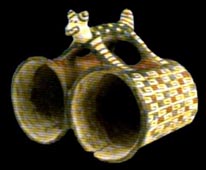
Diaguita culture, agricultural and ceramist, existed between the VIIIth and XVth centuries A.D., and it was contemporary to the Atacameño culture.
This ethnic group probably was related with the Argentinean Diaguitas; in the the Vth and VIth centuries A.D., the Diaguitas people may have crossed the Andean range to settle in the fertile valleys of the Copiapó, Huasco, Elqui, Limarí and Choapa rivers. Their arrival of the Diaguitas people is thought to have replaced the Molle culture, which extended from the valley of the Huasco, in the north, to the Choapa, in the south.
Diaguitas people are known for their ceramic art, which is characterized by their fine trimmings and rich decoration with geometric figures: straight lines, zigzags and triangles embedded in a line. They preferred colors as white, red and black.
Their pottery may be classified in two groups of vessels, one for everyday life, as the so called shoe vessels, and the other for ceremonial and ritual purposes: the much finer and more elaborated duck vessels.